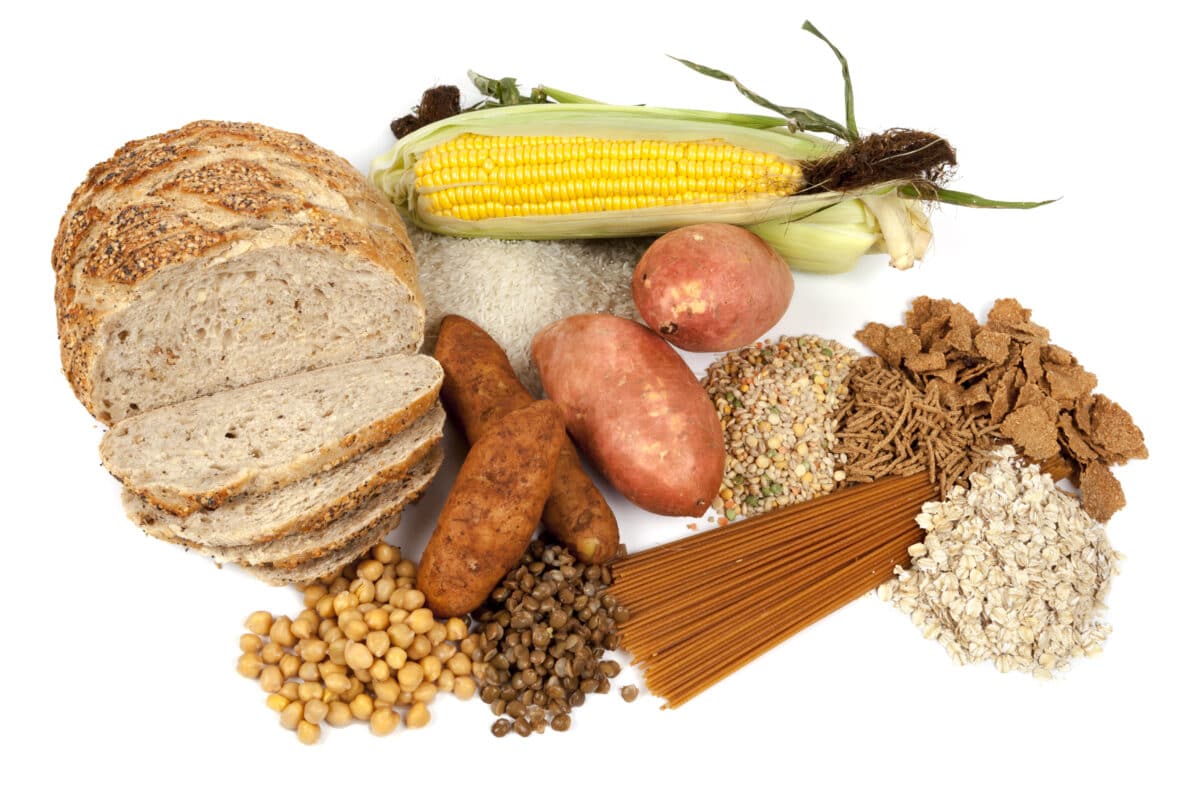
(Photo by Prostock-studio on Shutterstock)
Cornell University study links starch to oral bacteria — but not everyone has the same risk
In a nutshell
- The number of AMY1 gene copies you have affects how your mouth’s bacteria respond to starchy foods like bread and pasta, potentially influencing your risk for cavities and gum disease.
- People with higher AMY1 copy numbers break down starch more efficiently, but this genetic advantage might require extra vigilance about brushing after eating starchy foods.
- This research explains why some people might be more susceptible to dental problems than others, even with similar oral hygiene habits, and could lead to more personalized dental care recommendations in the future.
ITHACA, N.Y. — Brushing your teeth after eating starchy foods might be more important for some people than others, according to new research from Cornell University. Scientists have discovered that variations in a specific gene affecting starch digestion can influence the bacteria in our mouths—potentially affecting our risk for cavities and gum disease.
Led by Dr. Angela Poole at Cornell’s Division of Nutritional Sciences, the study found that the number of copies of the AMY1 gene—which produces salivary amylase, the enzyme that starts breaking down starch in your mouth—affects how oral bacteria respond to starchy foods. This connection might explain why some people get more dental problems than others, even with similar oral hygiene habits.
“Most people have been warned that if you eat a bunch of sugar, make sure you brush your teeth,” said Angela Poole, senior author and assistant professor of molecular nutrition, in a statement. “The takeaway finding here is that depending on your AMY1 copy number, you may want to be just as vigilant about brushing your teeth after eating those digestible starches.”
The number of AMY1 gene copies varies widely among individuals, from as few as 2 to as many as 20 copies. People with more copies produce more salivary amylase and break down starchy foods more efficiently. This genetic variation evolved as humans shifted to agricultural diets with higher starch content thousands of years ago.

Linking Starchy Foods To Cavity-Causing Oral Bacteria
The research team grew bacteria from saliva samples of 31 adults with varying AMY1 copy numbers in laboratory conditions. They created dental plaque-like cultures both with and without starch to see how the bacteria would respond.
“That’s what we wanted to know in this experiment,” Poole said. “What’s going on in the mouth if someone eats starch, and is the answer different if their copy number is high or if it’s low? What we found was that there are other bacteria involved in these processes and that the changes depended on AMY1.”
Their findings, published in Microorganisms, were revealing: bacteria from people with high AMY1 copy numbers responded differently to starch than those from people with fewer copies. When starch was present, two types of bacteria—Veillonella and Atopobium—were less abundant in samples from high-AMY1 donors. Both these bacteria have been linked to cavities and gum disease.
“If someone has a high copy number, they break down starch efficiently, and bacteria that like those sugars are going to grow more in that person’s mouth,” Poole said. “So you can have species behave differently based on the different substrates. It’s pretty incredible – how we adapt and these microbes turn around and adapt, too.”
How to Determine Your AMY1 Copy Number
Currently, there’s no widely available consumer test specifically designed to measure your AMY1 copy number. However, there are several indicators and testing options that might give you insight:
Possible Indicators
- If you find starchy foods taste very sweet to you immediately upon chewing (before swallowing), you might have higher amylase activity and potentially more AMY1 copies.
- People with ancestry from populations with long histories of agriculture (many European, Middle Eastern, and some Asian populations) tend to have higher average AMY1 copy numbers than those from traditional hunter-gatherer populations.
Testing Options
- Some specialized genetic testing companies may offer copy number variation testing that includes AMY1, though this is not typically included in standard consumer DNA tests.
- Certain academic research studies occasionally recruit participants for AMY1 testing.
- A healthcare provider might be able to order a salivary amylase activity test, which measures the enzyme’s activity (correlated with copy number) rather than the gene copies directly.
- In some cases, raw data from consumer DNA tests can be analyzed using third-party tools to estimate AMY1 copy number, though with limited accuracy.
Practical Approach
Since the research is still emerging and testing isn’t readily accessible, a sensible approach would be to:
- Pay attention to how your teeth and gums respond to starchy foods
- Brush after consuming highly processed starchy foods regardless of your genetic makeup
- Consider adopting the precautionary principle—assume you might have higher AMY1 copies and adapt your oral hygiene accordingly
Note: This study doesn’t suggest everyone needs genetic testing for dental care. Rather, it helps explain why some people might be more susceptible to starch-related dental issues than others, potentially leading to more personalized recommendations in the future.
The evolutionary story adds another dimension. Scientists believe that humans developed multiple copies of this gene following the agricultural revolution about 10,000 years ago. Having more copies would have helped our ancestors extract more calories from starchy foods during times of scarcity.
“The populations that historically had greater access to starch tend to have more copies,” Poole explained, “which makes sense from a practical standpoint, because it would have given you a survival advantage when food is scarce, to be able to break down those starches more efficiently.”
A Less-Diverse Oral Microbiome
The study also found that starch decreased the diversity of bacterial communities in the biofilms. Additionally, samples from donors with periodontitis (advanced gum disease) had significantly lower bacterial diversity compared to those from individuals with healthy gums.
In samples with high AMY1 copy numbers, the researchers saw increased populations of Streptococcus bacteria that feed off starch breakdown products. While some Streptococcus species cause cavities, others are beneficial and may help inhibit harmful bacteria.

In previous research, Poole found that high AMY1 copy numbers were associated with higher levels of Porphyromonas endodontalis, a species strongly linked to gum disease. This new study helps explain how salivary amylase interacts with starch to shape the mouth’s bacterial community and potentially affect disease risk.
These findings may eventually lead to more personalized dental care. If your AMY1 copy number influences how your oral bacteria respond to starch, dentists might someday offer different dietary and hygiene recommendations based on your genetic profile. For example, people with certain AMY1 profiles might benefit from extra careful brushing after eating starchy foods.
This study is a great reminder that when it comes to dental health, one-size-fits-all advice might not work for everyone. Your genes could be influencing how your mouth processes starchy foods, meaning some people might need to be extra diligent about brushing after a carb-heavy meal. So next time you reach for that slice of bread or bowl of pasta, just remember: your AMY1 genes might have something to say about it!
Starchy Foods to Watch Out For
Based on the research, these starchy foods might warrant extra attention to brushing, especially if you have a high AMY1 copy number:
- White bread and rolls
- Pasta and noodles
- White rice
- Crackers and pretzels
- Potato chips
- French fries
- Mashed potatoes
- Breakfast cereals (especially refined ones)
- Pastries and donuts
- Cookies and cakes
- Pizza dough
- Bagels
- Corn-based snacks
- Instant oatmeal
- Refined flour tortillas
Lower-risk starchy foods (whole grain/slowly digestible starches):
- Brown rice
- Whole grain bread
- Steel-cut oats
- Quinoa
- Barley
- Beans and legumes
- Sweet potatoes
- Whole wheat pasta
Remember: The research suggests that people with higher AMY1 copy numbers may need to be especially vigilant about brushing after consuming rapidly digestible starches.
Paper Summary
Methodology
The researchers collected saliva from 31 adults aged 19-57 years with varying AMY1 copy numbers (between 2 and 20 copies). Participants reported whether they had gum disease, including periodontitis, gingivitis, or gum recession. The team determined each person’s AMY1 copy number and measured their salivary amylase activity.
To create lab models of dental plaque, the researchers used each donor’s saliva to seed cultures in two types of growth media: one with starch and one without. The growth medium was specially designed to support mouth bacteria. The cultures grew without oxygen for 48 hours to simulate mouth conditions. Afterward, researchers identified the types and amounts of bacteria in each culture.
Results
The study showed that each person’s individual bacterial makeup strongly influenced what grew in their laboratory cultures. Bacterial diversity was lower in cultures with starch compared to those without it, suggesting that starch promoted the growth of specific bacteria.
The most important finding was that two types of bacteria—Veillonella and Atopobium—were significantly affected by the combination of AMY1 copy number and starch. As AMY1 copy number increased, these bacteria became less abundant when starch was present but more abundant when starch was absent. Both bacteria have been associated with dental problems in previous studies.
Limitations
The study had several limitations. With only 31 participants (11 reporting some form of gum disease), the sample size was relatively small. Participants self-reported their gum disease status rather than being clinically diagnosed. The laboratory setup couldn’t fully replicate the complex environment of the human mouth, and the researchers couldn’t identify bacteria at the species level—only broader groups—which means they couldn’t distinguish between harmful and beneficial bacteria within the same group.
Takeaways: Why This Matters
This research shows a clear interaction between our genes (specifically AMY1 copy number) and diet (starch) in shaping the bacteria in our mouths. People with high AMY1 copy numbers break down starch more efficiently, potentially creating different environments for bacteria compared to those with fewer AMY1 copies.
For everyday dental care, this suggests that personalized approaches might be beneficial. While we can’t change our genes, understanding how they influence our susceptibility to dental issues might help us make better choices about our diet and oral hygiene practices.
Funding and Publication Information
The research was supported by the Schwartz Research Fund and the National Institutes of Health. The study “The Impact of Human Salivary Amylase Gene Copy Number and Starch on Oral Biofilms” was published in the journal Microorganisms in February 2025 and is available to read online.







